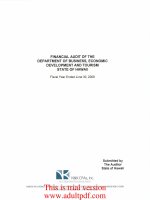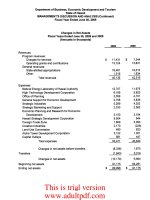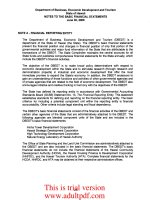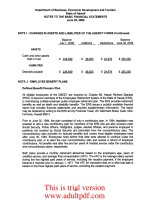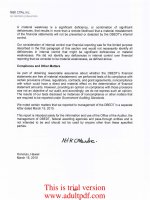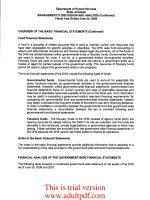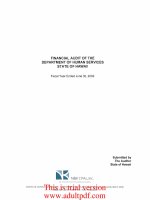FINANCIAL AUDIT OF THE DEPARTMENT OF BUSINESS, ECONOMIC DEVELOPMENT AND TOURISM STATE OF HAWAII Fiscal Year Ended June 30, 2009 _part3 ppt
Bạn đang xem bản rút gọn của tài liệu. Xem và tải ngay bản đầy đủ của tài liệu tại đây (478.4 KB, 12 trang )
Department
of
Business,
Economic
Development and Tourism
State
of
Hawaii
NOTES
TO
THE BASIC FINANCIAL STATEMENTS
June
30,
2009
NOTE A - FINANCIAL REPORTING ENTITY
The Department of Business, Economic Development and Tourism (DBEDT)
is
a
department of the State of Hawaii (the State). The DBEDT's basic financial statements
present the financial position and changes
in
financial position of only that portion of the
governmental activities and major fund information of the State that are attributable
to
the
transactions of the DBEDT. The State Comptroller maintains the central accounts for
all
State funds and publishes comprehensive financial statements for the State annually, which
include the DBEDT's financial activities.
The objective of the DBEDT
is
to
make broad policy determinations with respect
to
economic development within the State and
to
stimulate research (through research
and
demonstration projects)
in
industrial and economic development that offer the most
immediate promise to expand the State's economy.
In
addition, the DBEDT endeavors
to
gain
an
understanding of those functions and activities of other governmental agencies
and
of private agencies that are related to the field of economic development. The DBEDT also
encourages initiative and creative thinking
in
harmony with the objectives of the DBEDT.
The State has defined its reporting entity
in
accordance with Governmental Accounting
Standards Board (GASB) Statement
No.
14,
The Financial Reporting Entity. This statement
establishes standards for defining and reporting
on
the financial reporting entity. The basic
criterion for including a potential component unit within the reporting entity is financial
accountability. Other criteria include legal standing and fiscal dependency.
The DBEDT's basic financial statements consist of the financial activities of the DBEDT
and
certain other agencies of the State that are administratively attached
to
the DBEDT. The
following agencies are blended component units of the State and are included
in
the
DBEDT's basic financial statements:
Aloha Tower Development Corporation
Hawaii Strategic Development Corporation
High Technology Development Corporation
Natural Energy Laboratory of Hawaii Authority
The Office of State Planning and the Land Use Commission are administratively attached
to
the DBEDT and are also included
in
the basic financial statements. The DBEDT's basic
financial statements do not include the financial statements of the Hawaii Community
Development Authority (HCDA), the Hawaii Housing Finance
& Development Corporation
(HHFDC), and the Hawaii Tourism Authority (HTA). Complete financial statements for the
HCDA, HHFDC, and HTA may
be
obtained at their respective administrative offices.
25
This is trial version
www.adultpdf.com
Department
of
Business,
Economic
Development
and
Tourism
State
of
Hawaii
NOTES TO THE BASIC FINANCIAL STATEMENTS
June
30, 2009
NOTE B - SIGNIFICANT ACCOUNTING POLICIES
The basic financial statements
of
the DBEDT have been prepared
in
conformity with
generally accepted accounting principles in the United States
of
America (GAAP), as
applicable to governmental units. The GASB
is
the accepted standard-setting body for
establishing governmental accounting and financial reporting principles.
(1)
Basis
of
Presentation - The government-wide financial statements, which are the
statement
of
net assets and the statement of activities, report information
on
all
of
the
nonfiduciary activities of the DBEDT. The effect of interfund activity has been removed
from these government-wide financial statements.
The statement
of
activities demonstrates the degree
to
which the direct expenses of a
given function are offset by program revenues. Direct expenses are those that are clearly
identifiable with a specific function. Program revenues include charges to customers who
purchase, use, or directly benefit from goods or services provided by a given function.
Program revenues also include grants and contributions that are restricted to meeting the
operational or capital requirements
of
a particular function. State allotments and other
items properly not included among program revenues are reported instead as general
revenues. Resources that are dedicated internally are reported as general revenues rather
than program revenues.
Net assets are restricted when constraints placed
on
them are either externally imposed or
imposed
by
constitutional provisions or enabling legislation. Internally imposed
designations of resources are not presented as restricted net assets. When both restricted
and unrestricted resources are available for use, it
is
generally the DBEDT's policy to use
restricted resources first, then unrestricted resources as they are needed.
The financial activities
of
the DBEDT are recorded
in
individual funds, each
of
which
is
deemed to
be
a separate accounting entity. The DBEDT uses fund accounting to report
on
its financial position and results of operations. Fund accounting
is
designed to demonstrate
the legal compliance and to
aid
financial management
by
segregating transactions related
to certain government functions or activities. A fund
is
a separate accounting entity with a
self-balancing set
of
accounts.
Separate financial statements are provided for governmental funds and fiduciary funds.
However, the fiduciary funds are not included
in
the government-wide financial statements.
Major individual governmental funds are reported as separate columns
in
the fund financial
statements.
The financial activities of the DBEDT that are reported
in
the accompanying fund financial
statements have been classified into the following major governmental funds.
In
addition, a
description
of
the DBEDT's fiduciary fund
is
as follows.
26
This is trial version
www.adultpdf.com
Department
of
Business, Economic Development and Tourism
State
of
Hawaii
NOTES
TO
THE
BASIC FINANCIAL STATEMENTS
June
30,
2009
NOTE B - SIGNIFICANT ACCOUNTING POLICIES (Continued)
Governmental Fund Types
The DBEDT reports the following major governmental funds:
General
Fund
This fund
is
the DBEDT's primary operating
fund.
It accounts for
all
financial
activities of the DBEDT, except those required to
be
accounted for
in
another
fund. The annual operating budget
as
authorized
by
the State Legislature
provides the basic framework within which the resources
and
obligations of
the
general fund are accounted.
Economic Development Special Revenue
Fund
This fund accounts for
all
programs related
to
the
development
and
promotion of
industry
and
international commerce, energy development
and
management,
economic research
and
analysis,
and
the utilization of resources.
Capital Projects
Fund
This fund accounts for financial resources
to
be
used
for the acquisition or
construction of major capital facilities.
Fiduciary Fund Type
Agency
Fund
This fund accounts for assets held
by
the
DBEDT
in
an
agency capacity.
(2)
Measurement Focus
and
Basis
of
Accounting
-
The
government-wide statement of
net assets
and
statement of activities are accounted for
on
a flow of economic
resources measurement focus. With this measurement focus,
all
assets
and
all
liabilities associated with the operation of these activities are included
on
the
statement of net assets.
The accounting
and
financial reporting treatment applied
to
a fund
is
determined
by
its
measurement focus.
All
governmental funds are accounted for using a current
financial resources measurement focus. With this measurement focus, only current
assets
and
current liabilities generally are included
on
the balance sheet. Operating
statements of these funds present increases (i.e., revenues
and
other financing
sources)
and
decreases (i.e., expenditures
and
other financing uses)
in
net current
assets.
27
This is trial version
www.adultpdf.com
Department
of
Business,
Economic
Development
and
Tourism
State
of
Hawaii
NOTES TO THE BASIC FINANCIAL STATEMENTS
June
30,2009
NOTE B - SIGNIFICANT ACCOUNTING POLICIES (Continued)
The modified accrual basis
of
accounting is used by all governmental fund types and
trust funds. Under the modified accrual basis of accounting, revenues such as interest
are recognized when susceptible to accrual (Le., when they become both measurable
and available to finance operations
of
the fiscal year
or
liquidate liabilities existing at
year-end).
Measurable means that the amount of the transaction can
be
determined. Available
means that the amount is collected
in
the current fiscal year or soon enough after
year-end to liquidate liabilities existing at the end of the fiscal year. The DBEDT
considers receivables collected within 60 days after year-end to be available and
recognizes them as revenues
of
the current fiscal year. Expenditures are recorded
when the related fund liability
is
incurred.
The DBEDT reports deferred revenues on its statement of net assets and balance
sheet. Deferred revenues arise when both the "measurable" and "available" criteria for
recognition are not met
in
the current period. Deferred revenues also arise when the
DBEDT receives resources before it has a legal claim to them, as when grant monies
are received prior to the incurrence of qualifying expenditures.
In
subsequent periods,
when both revenue recognition criteria are met,
or
when the DBEDT has a legal claim
to the resources, the liability for the deferred revenue
is
removed from the statement
of
net assets and balance sheet and revenue is recognized.
Encumbrances represent commitments related to unperformed contracts for goods or
services. Encumbrance accounting, under which purchase orders, contracts, and other
commitments for the expenditure of resources are recorded to reserve that portion of the
applicable appropriation,
is
utilized
in
the governmental funds. Encumbrances outstanding
at year-end are reported
as
reservations of fund balances and do not constitute
expenditures or liabilities because the commitments
will
generally
be
honored during the
subsequent fiscal year.
(3)
Use
of
Estimates - The preparation of basic financial statements
in
conformity with GAAP
requires management to make estimates and assumptions that affect the reported
amounts of assets and liabilities,
as
well as disclosure of contingent assets and liabilities
at
the date of the basic financial statements, and the reported amounts of revenues,
expenditures, and other financing sources and uses during the reporting period. Actual
results could differ from those estimates.
(4)
Investments -Investments
in
venture capital limited partnerships
are
carried at cost, which
amounted to $8,974,073 at June
30,
2009. The fair value of these investments
approximated $5,488,931 at June
30,
2009. Fair value of the DBEDT's limited partnership
interests
is
based on the fair value of the underlying securities owned by the limited
partnerships obtained from international and national security exchanges or
is
based
on
estimated values. The DBEDT has outstanding commitments
to
fund these venture capital
funds of
$1
,421
,786 at June 30,2009.
28
This is trial version
www.adultpdf.com
Department
of
Business,
Economic
Development
and
Tourism
State
of
Hawaii
NOTES TO THE BASIC FINANCIAL STATEMENTS
June
30, 2009
NOTE B - SIGNIFICANT ACCOUNTING POLICIES (Continued)
(5)
Capital Assets - Capital assets include land and
land
improvements, infrastructure
assets, buildings and improvements, equipment, and all other tangible and intangible
assets that are used
in
operations and that have initial useful lives extending beyond a
single reporting period. Capital assets are recorded at historical cost or estimated
historical cost if purchased or constructed. Donated capital assets are recorded at their
estimated fair market value at the date
of
donation.
Maintenance and repairs are charged to operations when incurred. Betterments
and
major improvements which significantly increase values, change capacities, or extend
useful lives are capitalized. Upon sale or retirement of capital assets, the cost and the
related accumulated depreciation, as applicable,
are
removed from the respective
accounts, and any resulting gain or loss
is
recognized
in
the statement of activities.
Capital assets are depreciated using the straight-line method over the useful lives
below.
The State has adopted the following capitalization policy:
Minimum
Capitalization Estimated
Asset Type Amount Useful Life
Land All Not applicable
Land improvements
$ 100,000
15 years
Buildings and improvements
$ 100,000 30 years
Furniture and equipment
$
5,000 7 years
Motor vehicles
$ 5,000
5 years
(6)
Compensated Absences - The DBEDT permits employees to accumulate earned but
unused vacation and sick leave benefits. There
is
no liability for unpaid accumulated sick
leave since sick leave
is
not convertible to pay
upon
termination of employment. All
vacation pay
is
accrued when incurred. Employees are credited with vacation at the rate
of 168 hours per calendar year. Accumulation of such vacation credits
is
limited to 720
hours at calendar year-end and
is
convertible to pay upon termination of employment.
Such accumulated vacation has been accrued and reflected
in
the statement of net
assets.
(7)
Appropriations
- Appropriations represent the authorizations granted by the State
Legislature that permit a state agency, within established fiscal and budgetary
controls, to incur obligations and to make expenditures. Appropriations are allotted
quarterly. The allotted appropriations lapse if not expended by or encumbered at the
end
of
the fiscal year.
29
This is trial version
www.adultpdf.com
Department
of
Business,
Economic
Development
and
Tourism
State
of
Hawaii
NOTES TO THE BASIC FINANCIAL STATEMENTS
June
30, 2009
NOTE B - SIGNIFICANT ACCOUNTING POLICIES
(Continued)
(8)
Program Revenues - The DBEDT'charges various program fees that include office
space and facility rental fees, ground rent fees, storage service fees, maintenance
fees, and facility management fees.
Federal grant and assistance awards made on the basis
of
entitlement periods are
recorded as revenue when available and entitlement occurs. All other federal
reimbursement-type grants are recorded as receivables and revenues when the
related expenditures are incurred.
(9)
Deferred Revenue - Deferred revenue at the fund and government-wide level arise
when the DBEDT receives resources before it has a legal claim to them.
In
subsequent
periods, when the revenue recognition criteria is met, or when the DBEDT has a legal
claim to the resources, the liability for deferred revenue
is
removed from the statement
of net assets and balance sheet" and revenue is recognized. Deferred revenue at
June 30, 2009, consists primarily of federal grant funds for which
all
eligibility
requirements have not yet been met.
(10)
Nonexchange Transactions - The DBEDT records grant revenue only when
all
eligibility
requirements have been met and amounts are available,
(11)
Intrafund
and
Interfund Transactions - Transfers of financial resources within the same
fund are eliminated, Transfers from funds receiving revenues
to
funds through which the
resources are
to
be
expended are recorded as transfers.
(12)
Risk Management - The DBEDT
is
exposed to various risks for losses related
to
torts;
theft
of,
damage
to,
or destruction of assets; errors
or
omissions; natural disasters;
and
injuries to employees, A liability for a claim for a risk of loss
is
established if information
indicates that
it
is
probable that a liability has been incurred at the date of the basic
financial statements and the amount of the loss
is
reasonably estimable.
(13)
Deferred Compensation Plan - The State offers its employees a deferred
compensation plan created
in
accordance with Internal Revenue Code Section 457,
The plan, available to all state employees, permits employees to defer a portion of
their salary until future years. The deferred compensation
is
not available to
employees until termination, retirement, death, or unforeseeable emergency.
All plan assets
are
held
in
a trust fund to protect them from claims of general creditors. The
State has
no
responsibility for loss due
to
the investment or failure of investment of funds
and assets
in
the
plan,
but does have the duty of due care that would
be
required of
an
ordinary prudent investor. Accordingly, the assets
and
liabilities of the State's deferred
compensation plan are not reported
in
the accompanying basic financial statements.
30
This is trial version
www.adultpdf.com
Department
of
Business,
Economic
Development
and
Tourism
State
of
Hawaii
NOTES TO THE BASIC FINANCIAL STATEMENTS
June
30, 2009
NOTE C - BUDGETING AND BUDGETARY CONTROL
The bUdget
of
the DBEDT
is
a detailed operating plan identifying estimated costs and results
in
relation to estimated revenues. The budget includes
(1)
the programs, services, and activities to
be provided during the fiscal year, (2) the estimated revenues available to finance the operating
plan, and
(3)
the estimated spending requirements of the operating plan. The budget represents
a process through which policy decisions are made, implemented, and controlled.
Revenue estimates are provided to the State Legislature at the time
of
budget consideration
and
are revised and updated periodically during the fiscal year. Amounts reflected as budgeted
revenues
in
the statement of revenues and expenditures - budget and actual (budgetary basis) -
general and economic development special revenue funds
are
those estimates as compiled
and
reviewed
by
the DBEDT.
Budgeted expenditures are derived primarily from the General Appropriations Act of 2008 (Act
213, Session Laws
of
Hawaii (SLH) 2008), and from other authorizations contained
in
the State
Constitution, HRS, and other specific appropriations acts
in
various SLH.
All expenditures
of
these appropriated funds are made pursuant to the appropriations
in
the
fiscal 2008 - 2010 biennial budget. The general and economic development special revenue
funds have legally appropriated annual budgets. Capital projects fund appropriated budgets are
for projects that may extend over several fiscal years.
The final legally adopted budget
in
the accompanying statement
of
revenues and expenditures -
bUdget and actual (budgetary basis) - general and economic development special revenue funds
represents the original appropriations, transfers, and other legally authorized legislative
and
executive changes.
The legal level
of
budgetary control
is
maintained at the appropriation line item level
by
department, program, and source of funds· as established
in
the appropriations
act.
The
Governor
is
authorized to transfer appropriations between programs within the same department
and source
of
funds; however, transfers
of
appropriations between departments generally
require legislative authorization. Records and reports reflecting the detail level of control are
maintained by and are available at the State Department
of
Accounting and General Services.
During the fiscal year ended June
30,
2009, there were no expenditures
in
excess of
appropriations at the legal level
of
budgetary control.
To the extent not expended or encumbered, general
and
economic development special
revenue funds appropriations generally lapse at the end
of
the fiscal year for which the
appropriations are made. The State Legislature specifies the lapse dates and any other
contingencies which may terminate the authorizations for other appropriations.
Budgets adopted by the State Legislature for the general
and
economic development special
revenue funds are presented
in
the accompanying statement of revenues and expenditures -
budget and actual (budgetary basis) - general and economic development special revenue
funds. The DBEDT's annual budget
is
prepared
on
the modified accrual basis of accounting with
31
This is trial version
www.adultpdf.com
Department
of
Business, Economic Development and Tourism
State
of
Hawaii
NOTES
TO
THE BASIC FINANCIAL STATEMENTS
June
30,
2009
NOTE C - BUDGETING AND BUDGETARY CONTROL (Continued)
several differences from the preparation
of
the statement
of
revenues, expenditures,
and changes
in
fund balances, principally related to (1) encumbrance
of
purchase
orders and contract obligations, (2) accrued revenues and expenditures, and (3)
unbudgeted programs (federal award programs).
The
first two differences represent
departures from GAAP.
A
reconciliation
of
the
budgetary
to
GAAP
basis
operating
results
for
the
fiscal
year
ended
June
30, 2009
follows:
General
Economic
Development
Special
Revenue
$ (13,613,267)
17,814,994*2,087,396
(9,498,053)
(167,461)
(109,746)
(11,112,388)*
2,797,663*
(27,064)*
(1,276,864)
$ (7.687.864) $ (5.416,926)
$
Net change
in
fund balances - GAAP basis
Excess of revenues over (under) expenditures
and
other
uses
- actual
on
a budgetary basis
Reserved for encumbrances
at
fiscal year-end
Expenditures for liquidation of prior fiscal year
encumbrances
Net
accrued revenues
and
expenditures
Net changes
in
unreserved liabilities
Unbudgeted revenues
and
other financing sources
net of expenditures
and
other financing uses
* Amounts reflect the balances related
to
budgeted programs
only.
NOTE D - CASH AND INVESTMENTS
Cash
in
State Treasury
The
State Director
of
Finance (Director) is responsible for the safekeeping
of
all
monies paid into the State Treasury. The Director pools and invests any monies
of
the State, which in the Director's judgment, are
in
excess
of
amounts necessary for
meeting the immediate requirements
of
the State. Legally authorized investments
include obligations of,
or
guaranteed
by,
the U.S. Government, obligations
of
the State,
federally-insured savings and checking accounts, time certificates
of
deposit, and
repurchase agreements with federally-insured financial institutions. Information relating
to
the bank balance, insurance,
and
collateral of
cash
deposits
is
determined
on
a statewide
basis
and
not for individual departments or divisions.
32
This is trial version
www.adultpdf.com
Department
of
Business, Economic Development and Tourism
State
of
Hawaii
NOTES
TO
THE
BASIC FINANCIAL STATEMENTS
June 30,2009
NOTE D - CASH AND INVESTMENTS (Continued)
DBEDT was informed by the State Department of Accounting and General Services that State
agencies participating
in
the State Treasury Investment
Pool
that the State's investments
in
auction rate securities were impaired
as
of and for the fiscal year ended June
30,
2009 and that
each participating State agency would
be
allocated a portion of the impairment
loss.
DBEDT's
allocated impairment loss for the fiscal year ended June
30,
2009, totaled $1,535,138.
Interest Rate Risk
As a means of limiting its exposure to fair value losses arising from rising interest rates, the
State's investment policy generally limits maturities on investments to not more than five years
from the date of investment.
Credit Risk
The State's investment policy limits investments
in
state
and
U.S.
Treasury securities, time
certificates of deposit,
U.S.
government or agency obligations, repurchase agreements,
commercial paper, bankers' acceptances, and money market funds and student loan resource
securities maintaining a Triple-A rating.
Custodial Credit Risk
For an investment, custodial credit risk
is
the risk that,
in
the event of the failure of the
counterparty, the State will not be able to recover the value of its investments or collateral
securities that are
in
the possession of
an
outside party. The State's investments are held at
broker/dealer firms which are protected by the Securities Investor Protection Corporation (SIPC)
up to a maximum amount.
In
addition, excess-SIPC coverage
is
provided by the firms' insurance
policies.
In
addition, the State requires the institutions to set aside
in
safekeeping, certain types
of securities to collateralize repurchase agreements. The State monitors the market value of
these securities and obtains additional collateral when appropriate.
Concentration
of
Credit Risk
The State's policy provides guidelines for portfolio diversification
by
placing limits
on
the amount
the State may invest
in
anyone
issuer, types of investment instruments, and position limits per
issue
of
an investment instrument.
Cash in Bank
The carrying value
of
the DBEDT's cash in bank balance of $1,046,960 ($1,024,280 for the
governmental funds and $22,680 for the fiduciary fund) equals the bank balance and was
uncollateralized at June 30, 2009. Such balance primarily represents the DBEDT's bank
accounts maintained for out-of-state operations, the Hawaii Strategic Development
Corporation program, the High Technology Innovation Corporation, and security deposits
held
for
the Foreign-Trade Zone Division, the High Technology Development Corporation,
and the Natural Energy Laboratory
of
Hawaii Authority.
33
This is trial version
www.adultpdf.com
Department
of
Business,
Economic
Development
and
Tourism
State
of
Hawaii
NOTES TO THE BASIC FINANCIAL STATEMENTS
June
30, 2009
NOTE E - ACCOUNTS AND LOANS RECEIVABLE
At
June 30, 2009, accounts and loans receivable consisted
of
the following:
Accounts Loans
receivable receivable
Foreign-Trade Zone Division
$
32,113
$
Natural Energy Laboratory
of
Hawaii Authority 1,096,747
High Technology Development Corporation 63,205
Financial Assistance Branch:
Hawaii Capital Loan Program
3,253,914
Hawaii Innovation Development Loan Program 32,945
Hawaii Disaster Commercial Loan Program
9,990
1,192,065 3,296,849
Less allowance for doubtful accounts
495,090 2,266,295
$
696.975 $ 1.030.554
NOTE F - DUE TO OTHER STATE AGENCIES
The Aloha Tower Development Corporation (the ATDC), a blended component unit of the
DBEDT,
is
a State agency established under HRS Chapter 206J, primarily to redevelop the
Aloha Tower complex
in
Honolulu. The complex encompasses Piers 5 to 23 of Honolulu Harbor.
In
September 1993, the State Department
of
Transportation - Harbors Division (Harbors)
entered into a lease with the ATDC (ATDC lease) which grants the leasehold interest
in
portions
of
the Aloha Tower complex to the ATDC. The ATDC
is
required annually to reimburse Harbors
for any losses
in
revenues during the term
of
the lease caused by any action of the ATDC or the
developer and to provide replacement facilities for maritime activities at no cost to Harbors.
In
September 1993, the ATDC subleased lands surrounded
by
Piers 8 and 9 and a portion of
land surrounded by Pier
10
to a developer and entered into a capital improvements,
maintenance, operations, and securities agreement (Operations Agreement) with the developer
and Harbors. Harbors continues to operate the harbor facilities at Piers
8,
9,
and
10.
The lease
between the ATDC and the developer requires the developer to construct, at the developer's
cost, various facilities as designated
in
the developer's proposal and to reimburse Harbors for
all
losses
in
revenues and increased expenses which may
be
incurred by Harbors. The ATDC,
Harbors, and the developer agreed that
in
lieu of reimbursing Harbors for losses
in
revenues
during the construction period, the developer would perform certain work to repair the structure
of
Piers 8 through
11,
the cost of which would otherwise
be
incurred by Harbors. The developer
offsets the maximum allowable cost
of
repair
of
$1,100,000 against
its
obligation to Harbors for
losses
in
revenues.
34
This is trial version
www.adultpdf.com
Department
of
Business,
Economic
Development and Tourism
State
of
Hawaii
NOTES TO THE BASIC FINANCIAL STATEMENTS
June
30, 2009
NOTE F -
DUE
TO OTHER STATE AGENCIES (Continued)
Pursuant to this Operations Agreement, the developer
is
current
on
amounts owed to the ATOC
as of June
30,
2009. Pursuant to the ATOC lease, the ATOC owed Harbors $7,683,566 as of
June
30,
2009. This amount
is
reflected
in
the economic development special revenue fund
in
the OBEOT's basic financial statements.
NOTE G - CAPITAL ASSETS
Changes in capital assets during the fiscal year ended June 30, 2009 were as follows:
Balance,
Balance,
July
1,
2008
Additions
Deductions
June
30,
2009
Caoital
assets
not
beina
deoreciated
Land
$
2,950,000
$
_.
$
$
2,950,000
Construction
in
progress
701,978
331,047
(496,559)
536,466
Total
capital
assets
not
being
depreciated
3,651,978
331,047
(496,559)
3,486,466
Other
caoital
assets
Land
improvements
14,682,807
15,469
14,698,276
Buildings
and
improvements
59,021,786
937,244
59,959,030
Equipment
10,836,076
521,330
(44,567)
11,312,839
Total
other
caoital
assets
84,540,669
1,474,043
(44,567)
85,970,145
Less
accumulated
depreciation
for:
Land
improvements
(3,163,571
)
(959,162)
(4,122,733)
Buildings
and
improvements
(26,281,547)
(2,014,000)
(28,295,547)
Furniture,
fixtures,
and
equipment
(5,480,060)
(1,405,870)
43,160
(6,842,770)
Total
accumulated
depreciatiol
(34,925,178)
(4,379,032)
43,160
(39,261,050)
Total
capital
assets
being
depreciated,
net
49,615,491
(2,904,989)
(1,407)
46,709,095
$
53,267,469
$
(2,573,942)
$
(497,966)
$
50,195,561
35
This is trial version
www.adultpdf.com
Department
of
Business,
Economic
Development
and
Tourism
State
of
Hawaii
NOTES TO THE BASIC FINANCIAL STATEMENTS
June
30, 2009
NOTE G - CAPITAL ASSETS
(Continued)
During the fiscal year ended June 30, 2009, depreciation expense was charged to functions
of
the DBEDT as follows:
Amount
Natural Energy Laboratory
of
Hawaii Authority $
Creative Industries
High Technology Development Corporation
General Support for Economic Development
Foreign-Trade Zone
Office
of
Planning
Economic Planning and Research for Economic Development
Land Use Commission
Strategic Marketing and Support
Strategic Industries
Total depreciation expense
$
NOTE H - ACCRUED COMPENSATION ABSENCES
2,207,658
604,801
798,133
461,185
291,644
7,368
4,876
1,093
1,900
374
4.379.032
Changes in accrued compensation absences during the fiscal year ended June 30, 2009,
were as follows:
Amount
Balance, July
1,
2008
$
2,257,876
Additions 1,034,415
Reductions
(1,003,354)
Balance, June
30,2009
2,288,937
Less current portion
(673,557)
$
1.615.380
NOTE I - CHANGES IN ASSETS AND LIABILITIES OF THE AGENCY FUNDS
The
agency funds are purely custodial (assets equal liabilities) and thus do not involve the
measurement
of
results
of
operations. The changes in assets and liabilities
of
the agency
funds for the fiscal year ended June 30, 2009, were as follows:
36
This is trial version
www.adultpdf.com
